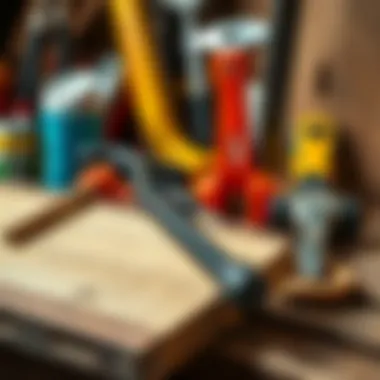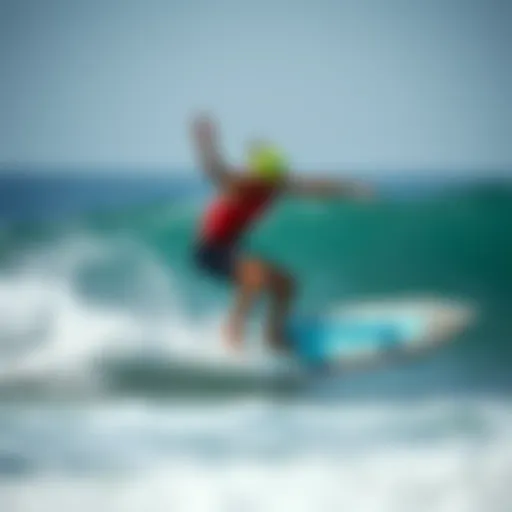Build a Mini Ramp: A Guide for Surfing Skills


Intro
Building a mini ramp can be a rewarding challenge for surfing enthusiasts who want to boost their skills and practice at home. This guide is designed to help you navigate through the entire process, from planning to construction and maintenance, all while keeping safety and practicality at the forefront. Here, you’ll find tips and tricks to create an ideal training space that can benefit both novices and seasoned surfers.
Creating a mini ramp isn’t just about nailing down some wood and hoping for the best. It involves thoughtful planning and an understanding of the sport's demands. Whether you're looking to work on your turns, aerial maneuvers, or just get comfortable with transitions, having a mini ramp can provide you the controlled environment necessary to perfect your techniques. So, let’s ride the wave of knowledge, and delve deeper into the essential sections of this ultimate guide.
Surfing Techniques
When building a mini ramp, it's important to think about the techniques you aim to improve. Understanding basic and advanced surfing maneuvers can significantly enhance your practice.
Beginner Tips for Getting Started
For those just starting out, the focus should be on mastering fundamental techniques. Here are some essential tips that can help:
- Balance: Start by getting comfortable on your board. Practice balancing on flat ground before hitting the ramp. Stand with feet shoulder-width apart and bend slightly at the knees.
- Pumping: Learning how to pump is vital for maintaining speed. Focus on using your knees to push down and lift your body, transferring weight fluidly when going up and down the ramp.
- Take it Slow: Don’t rush. Begin with gentle transitions and gradually increase your speed as you gain confidence with each movement.
Advanced Maneuvers and Tricks
Once you're comfortable with the basics, you might want to step up your game. Here are a few advanced techniques to consider incorporating into your practice:
- Aerials: Take the opportunity to practice ollies and grabs. Build your jump height by pushing off the tips of your board.
- Carving: Work on your carving skills by digging your toes and heels into the transitions. This can improve how you ride both on the wave and the ramp.
- Tricks Combos: Once you’re skilled at individual tricks, try linking multiple moves together for a smooth performance.
"Practice does not make perfect. Only perfect practice makes perfect." – Vince Lombardi
Surfboard Selection
Choosing the right surfboard before you start building your mini ramp is crucial. Each board comes with its own characteristics that can influence your practice.
Choosing the Right Board for Your Style
Selecting a surfboard depends heavily on your skill level, the type of waves you’re riding, and the tricks you want to learn. Here are some aspects to consider:
- Board Size: For beginners, a longer board provides more stability. Intermediate and advanced surfers might prefer shorter boards for maneuverability.
- Shape and Design: Boards come in various shapes like fish, longboards, or shortboards. Think about where you’ll practice and what style you favor.
- Materials: Consider boards made of polyurethane or epoxy. Each comes with different flex and durability properties.
Surfboard Maintenance and Care
Maintaining your board will ensure it lasts longer and performs better:
- Regular Cleaning: Rinse your board after each use to prevent salt and sand buildup.
- Dings and Repairs: Keep an eye on small dings and cracks. Perform repairs promptly to prevent water damage by using a repair kit or taking it to a professional.
Besides technical aspects, remember to enjoy yourself and appreciate every hole-in-the-wall surf spot you find while building your ramp. There’s a certain satisfaction in crafting something uniquely yours and watching your skill level rise as you clock in each hour on the ramp.
Preface to Mini Ramps in Surf Culture
In the world of surfing, where the ocean and skill converge, mini ramps serve as a unique avenue for enthusiasts to flex their creativity and improve their techniques while off the waves. These structures, often showcasing a smooth transition between vertical and flat surfaces, are not just playing fields for tricks, they represent a deeper connection among surfers who share a common passion for the sport.
Mini ramps have become particularly important as they cater to both beginners and seasoned surfers alike, providing a versatile platform for practice regardless of weather conditions. Imagine being able to hone that elusive backside air or frontside grab without the constraints of mother nature; it’s like having a slice of the ocean right in your backyard or local skate park.
The appeal of mini ramps extends beyond the technical skills; it nurtures a sense of community. Surfers flock to ramps not only to improve but to gather, share ideas, and collaborate on new tricks. Word around the campfire is that the energy found in these sessions can drive a surfer to push their limits further than they ever thought possible.
There’s something visceral about the sound of a board hitting the surface of a mini ramp, coupled with the exhilaration of completing a trick successfully. It’s more than just skating; it’s a synthesis of surf culture and creativity, where each rider can express their personal style, making each session unique.
That being said, building a mini ramp isn’t just about slapping a couple of boards together. There are numerous factors to consider – from selecting the right location to understanding the materials that best suit your local environment. A well-constructed mini ramp can provide hours of entertainment and skill enhancement.
Ultimately, mini ramps play a pivotal role in enriching the surfing experience, offering a sanctuary for improvement and a hub for community. As we delve deeper into this guide, we will uncover the nuances involved in designing, building, and maintaining your own mini ramp, ensuring that you're fully equipped to create a space that fosters both fun and learning.
"The beauty of a mini ramp is that it embodies the spirit of surfing: fluidity, creativity, and connection."
As we continue, let’s explore the purpose of a mini ramp, starting with how they serve as a foundation for skill development and innovative technique mastery.
Understanding the Purpose of a Mini Ramp
When surfers think about honing their skills, a mini ramp frequently comes to mind as a vital tool. Understanding the purpose of a mini ramp goes beyond merely having a place to practice tricks; it taps into the essence of physical and creative expression. This article aims to walk you through the myriad advantages tied to mini ramps, helping you grasp their significance in surf training and enjoyment.
Skill Development and Practice
A mini ramp serves as an excellent training ground, providing an ideal platform for surfers to develop balance, coordination, and agility. Instead of simply relying on waves, this structure enables you to practice moves repeatedly in a controlled environment.
- Repetition is Key: Surfers can try out moves over and over again without the unpredictability of ocean conditions. The ability to practice in a secure space can significantly speed up the learning curve.
- Improving Comfort Levels: Whether you are attempting to master a new maneuver or refine an existing skill, the ramp reduces the fear factor. You can fall safely onto a forgiving surface, making the learning experience less stressful.
- Builds Muscle Memory: Just like a skateboarder learns tricks on a half-pipe, surfers can also reinforce their muscle memory while using a mini ramp. This practice lays the groundwork for more advanced surfing maneuvers.
Innovative Techniques and Moves
Creativity thrives on a mini ramp. The very structure encourages trying out unconventional maneuvers that may not be possible in the ocean. By experimenting with different techniques, surfers gain more than technical skills; they develop a unique style.
- Unique Trick Combinations: The mini ramp acts as a platform for fusing surf and skate techniques. You can develop hybrid moves that would be difficult to execute on water, inspiring innovation in your surfing routines.
- Freestyle Exploration: The ramp allows for freestyle practice, promoting self-expression and individuality. Surfers can bring their unique flair, which might even lead to new trends or styles in the surf community.
- Community Inspiration: Being able to demonstrate and collaborate helps foster a communal environment. When surfers gather around a mini ramp, they share insights, tips, and encouragement, which enhances the overall surfing culture.
"Mini ramps are more than just wood and screws. They are a breeding ground for creativity and skill. Surfing innovation often stems from time spent off the waves."
In grasping the essential role that mini ramps play in skill enhancement and creative exploration, surfers can truly embrace them as an integral part of their surfing journey. By engaging with the ramp, you gain much more than just improved techniques; you become a part of a broader community that values continuous learning and creativity.
Planning Your Mini Ramp Construction
At the heart of building a mini ramp lies the crucial step of planning. Proper planning can mean the difference between a robust structure and a disappointing project that falls short of expectations. This phase is about laying a solid foundation not just for the ramp itself, but for a rewarding surfing experience. Each decision made during planning affects the construction, usability, and lifespan of the ramp.
In this guide, we’ll unpack various factors that influence the planning process, including location selection and design considerations.
Choosing the Right Location
Selecting the right location for your mini ramp is paramount. A well-chosen spot can greatly enhance your surfing practice. Look for a flat area with good drainage, away from overhanging branches or other obstructions. The ramp should be accessible yet in a place that won't bother the neighbors; it's a delicate balance between convenience and courtesy.
Factors to contemplate:
- Sunlight: Positioning your ramp where it can bask in the sun ensures faster drying after rain, promoting a better and safer riding surface.
- Space: Make sure there’s enough room not just for the ramp itself, but also for the activities, be it practicing your tricks or simply inviting friends over for a session.
Design Considerations


After you’ve locked in a location, the next step is deciding on the design. A mini ramp isn’t just a ramp—it’s a canvas for creativity and skill expression.
Dimensions and Size
The dimensions of the ramp directly relate to its usability and how challenging the experience will be for surfers. A common size for a beginner’s mini ramp might be around 3 feet high with a width of 8 feet. However, these numbers are flexible depending on the skill level and preferences of the user base.
A ramp of this size is a beneficial choice for beginners as it provides a manageable height that can still challenge growth in skill through practice. The unique feature of a ramp with these dimensions is that it allows for both smooth transitional rides and the potential for more radical tricks as skill develops.
Advantages:
- Easier for beginners to gain confidence
- More space for various tricks
Disadvantages:
- Extra length may require more space commitment
Configuration Options
Configuration options dictate the shape and flow of your mini ramp. Standard configurations are the classic U-shape or the half-pipe style, each with its own set of advantages.
The U-shaped ramp provides a good bit of versatility for tricks and allows for back-and-forth riding. On the other hand, a half-pipe setup supports continuous motion and holds great potential for more complex maneuvers.
Key Characteristics:
- U-Shape: Encouraging a back-and-forth flow; appealing for various techniques.
- Half-Pipe: Seamless transitions that can present unique challenges.
Benefits:
- U-shape invites exploration of transition tricks.
- Half-pipe favors speed and continuous flow.
Drawbacks:
- U-shape may require more deck space.
- Half-pipes can be daunting for new surfers.
"The beauty of a mini ramp lies in its capacity to challenge, entertain, and connect a community of surfers through shared experience."
By understanding these foundational elements of planning, you're already gearing yourself up for a successful mini ramp project. Take the time to consider these factors carefully and adjust your plans accordingly. Whether it’s the dimensions or the configuration, thoughtful planning sets the stage for a ramp that complements your surfing style and ambitions.
Materials Selection for Small Ramps
Choosing the right materials for your mini ramp isn’t just a matter of preference; it's crucial for the ramp's durability and performance. When it comes to surfing, every little detail counts, and your ramp is no exception. Selecting quality materials helps ensure that your construction withstands the daily wear and tear, and provides a solid surface to practice on.
Furthermore, making informed choices around materials can also affect safety. A well-constructed ramp can prevent unnecessary injuries, which is essential in any sport, especially one as dynamic as surfing. Moreover, with an array of materials available, understanding their properties will help you strike the right balance between weight, sturdiness, and cost-effectiveness.
Wood Types: Plywood versus OSB
The choice between plywood and OSB (Oriented Strand Board) is a classic debate among builders of mini ramps. Plywood is often favored by many due to its strength and moisture resistance. It’s less likely to warp over time, which ensures that the surface remains smooth and reliable. This is particularly advantageous for surfers keen on performing tricks.
On the flip side, OSB tends to be cheaper, making it appealing for those on a budget. However, it isn’t quite as rigid as plywood, which can lead to some sag over time. When it rains, OSB can absorb water easily, which could compromise its integrity. If you choose OSB, make sure to protect it with proper sealing to enhance its lifespan and maintain a better surface for surfing.
Other Essential Materials
Beyond wood, there are additional materials that you will require for your ramp, including fasteners, adhesives, and finishes. Each of these plays a pivotal role in ensuring that your construction is robust and user-friendly.
Fasteners and Adhesives
Fasteners and adhesives are the backbone of your ramp’s structural integrity. The right fasteners will hold everything together, with screws often being preferred over nails for their superior grip and holding strength. Hex screws, for instance, are quite popular as they provide a strong connection and resist stripping. Accessibility is another benefit; they’re easy to find and come in a variety of lengths for different needs.
Adhesives, on the other hand, serve to reinforce the joints and provide additional holding power. For outdoor use, waterproof adhesives are a must, as they can help prevent the deterioration of joins due to moisture exposure. A good adhesive will complement the fasteners and contribute to an overall increase in durability.
Surface Finish Options
The surface finish of your ramp is not just about aesthetics; it influences the riding experience significantly. A quality surface finish provides traction and improves comfort while surfing. A common choice for mini ramps is to use skateboarding-friendly paint or varnish which is designed to be durable and provide a reliable grip.
Another option is to install a specific surfacing material, such as friction coatings, which can modify the texture of the surface to enhance grip. Some finishes can wear out more quickly than others, so consider your usage frequency. While a glossy finish may look appealing, it typically provides less traction compared to a matte surface. Thus, balancing functionality and aesthetics is key.
In recap, careful selection of materials will ensure your mini ramp is built to last and effectively enhances your surfing performance. A thoughtful combination of quality materials will provide the structural soundness, safety, and enjoyment that every surfing enthusiast desires. For more in-depth insights and discussions on ramp building, you can explore resources like Wikipedia or engage with communities on platforms like Reddit to exchange ideas and experiences.
Essential Tools for Construction
Building a mini ramp isn't just about picking up some wood and getting to work. The right tools can make the difference between a smooth construction process and an exercise in frustration. A well-equipped toolbox allows you to work efficiently and safely, ensuring your ramp is not only well-structured but also sturdy enough to handle the rigorous activities that come with surfing practice. Let’s break down the essentials so you know exactly what you need before you dive in.
Power Tools Overview
When it comes to construction, power tools are your best friends. They speed up the process significantly and, if used right, can result in cleaner cuts and better finishes. Here are some power tools that every mini ramp builder should consider:
- Circular Saw: This is the champion for quickly cutting plywood or OSB sheets. You can adjust the depth to suit your needs. Make sure to use a fine-toothed blade for cleaner edges.
- Drill/Driver: Essential for making pilot holes and driving screws. A corded or cordless model works, but a cordless drill adds freedom of movement.
- Jigsaw: Handy for making curved cuts. It’s perfect if your ramp has specific shapes you want to create.
- Sander: A belt or orbital sander will make finishing touches smoother. It’s vital for eliminating splinters and ensuring a safe surface for riders.
Using power tools allows for efficiency, but never forget to read the manual and prioritize safety. Power tools can be intimidating for beginners, but with proper guidance and practice, you’ll be handling them like a pro.
Hand Tools That Make a Difference
While power tools can cover a lot of ground, hand tools still hold a special place in your construction arsenal. They offer precision and the ability to complete fine detail work that power tools sometimes overlook. Here are some essential hand tools:
- Tape Measure: Precision is key in ramp construction. A good tape measure will ensure your dimensions are spot on, so invest in one that’s at least 25 feet long.
- Square: A framing square helps ensure corners are at a perfect right angle. This tool is crucial, especially when laying the foundation of your ramp.
- Chisel and Hammer: For light adjustments or deeper cuts, a well-maintained chisel paired with a hammer can do the trick.
- Level: Keeping your ramp balanced is non-negotiable. A level is vital in ensuring that your ramp surfaces are even and safe to ride.
- Utility Knife: Useful for cleanly cutting smaller pieces of material, a utility knife can also remove errant pieces of wood that might create a hazard in the ramp design.
Incorporating both power and hand tools into your construction project ensures versatility and precision. Each tool plays a role, and understanding how they function will guide you in building a mini ramp that meets your specifications.
Remember: Safety first! Always put on appropriate protective gear, like goggles and gloves, when using any construction tools. The goal is to create a fun, safe environment for surfing practice, so start your project with a keen eye on safety and quality.
Step-by-Step Construction Process
Building a mini ramp is not just about nailing together some wood and calling it a day. The step-by-step construction process is crucial as it lays the groundwork for not only a robust structure but also a positive surfing experience. A well-built ramp can serve as a training ground for various surfing maneuvers, help improve balance, and allow enthusiasts to practice techniques in a controlled environment. Furthermore, understanding this process ensures that safety is prioritized, and the ramp can withstand daily wear and tear.
Laying the Foundation


Laying a solid foundation is the very first step. It might seem like a trivial task, but this initial stage significantly influences the ramp’s durability and overall stability. The foundation should be flat, level, and secure. Here’s what you need to consider:
- Location: Choose a spot that’s free from water pooling, should be away from trees to avoid falling branches, and enough space to allow smooth maneuvering.
- Surface Preparation: Clear away any debris or roots that may affect your ramp's structure. Dig slightly into the ground to lay a level base, using gravel as it helps with drainage.
- Anchor Points: These can be concrete blocks or treated wood supports, ensuring your ramp won’t shift over time.
Taking these steps can make a world of difference in how your ramp performs.
Framing the Ramp
Once the foundation is secure, it’s time to build the frame. This stage is where the ramp begins to take shape. Having solid framing is essential for supporting the structure and the surfers who will be using it. Consider the following points:
- Materials: Use quality materials, preferably pressure-treated wood to resist rotting and termites. 2x4s are typically a favorite choice for the framing.
- Design: Familiarize yourself with the recommended dimensions. A common size is a six-foot-wide ramp with a four-foot height for a gentle incline. Adjust according to your skill level.
- Assembly: Carefully construct the frame on the foundation, securing it tightly together with wood screws. This is a critical juncture where a precise alignment directly impacts performance. Pay extra attention to ensuring everything is square and plumb.
The strength of the ramp heavily lies in this phase; sloppiness here can lead to disaster down the line.
Surfacing and Finishing Touches
Now that the framing is complete, it’s time for the delightful part: surfacing and finishing! This phase is where aesthetics meet functionality. The surface needs to be smooth enough for surfing yet durable for consistent use. Here’s what to keep in mind:
- Plywood Selection: Use marine-grade plywood for the surface to prevent warping or splintering due to weather changes.
- Installation: Secure the plywood down using screws, ensuring a snug fit with no gaps. Leave certain spaces for drainage, which can help in the long run, especially after rain.
- Coating: Consider applying an anti-slip coating to the surface, as this enhances safety without compromising your ride. Adding a personal touch, like painting your mini ramp, can uplift its look and make it feel even more yours.
"The finishing touches aren’t just icing on the cake; they’re what make the cake worth eating."
Bringing it all together, the effects of good craftsmanship in every step take your ramp from simple construction to a valuable asset in your surfing toolkit.
This construction process guides you from foundation to finish, ensuring your mini ramp is ready to not only withstand the test of time but also elevates your surfing prowess. The satisfaction derived from building something functional and fun is immense, further connecting you with the wave-riding community.
For further insights, check out resources like Wikipedia for foundational techniques, or visit community forums on Reddit where fellow surfers discuss their ramp experiences and modifications.
Safety Considerations During Construction
Building a mini ramp isn’t just about stacking wood and creating an awesome place to practice surfing maneuvers. It involves a good dose of precaution and awareness. The stakes are higher than putting together LEGO; we're talking about physical safety here. When you set out to construct this surfboarding haven, being cautious and prepared can save you not only from injuries but also from regrets later on. Accidents happen, and ensuring a safe workspace is just as vital as meticulous planning and execution of your mini ramp.
Using Personal Protective Equipment
Before the hammer hits the wood, you gotta gear up. Personal Protective Equipment (PPE) is not just for the construction pros; it’s crucial for DIYers too. When you’re cutting, drilling, or even just moving the materials around, you could find yourself in a pickle if you’re not careful. Here are some essential items you should consider:
- Safety Goggles: Protects your peepers from flying debris or dust. Remember, those little specks are more sinister than they look.
- Gloves: Your hands are your most valuable tools. Wear sturdy work gloves to guard against splinters or sharp edges.
- Dust Masks: If you’re working with materials that generate dust fumes, a mask will help keep your lungs happy and healthy.
- Steel-Toed Boots: Protect your feet from heavy falling objects and provide better grip on slippery surfaces.
It’s better to look silly in a hard hat than to risk your noggin, right? Taking these simple steps can make the whole process smoother and less fraught with bumps, literally.
Structural Integrity and Stability
Next up, once you've got your gear on, turn your attention to ensuring the ramp's design and build is solid. A flimsy ramp can lead to disaster when you start hitting those tricks. Here’s what you should keep in mind:
- Foundation Matters: A mini ramp requires a level and stable foundation. If the ground beneath it isn’t solid, the whole structure will sway or, worse, collapse when in use.
- Quality Materials: Invest in good-quality lumber. Plywood or OSB that isn’t weathered will hold up much better against the trials of diving wheels and eager surfers.
- Load-Bearing Considerations: Always think about the weight that the ramp will support. Whether it’s your friends hanging out or their half-dozen surfboards stacked up, the ramp ought to endure that stress without buckle.
A study by the National Institute of Health emphasizes that one of the leading causes of injuries in construction is due to structural failures. Understanding your ramp's design thoroughly can help mitigate risks like this. Read more here
By blending safety through proper equipment with a focus on stability during the build, you’ll create not just a mini ramp, but a secure environment where surfers can hone their skills. Remember, no rush leads to no fuss. Take your time, do it right, and ride proudly knowing you built it safely.
Post-Construction Maintenance
Once you've put in the hard work of building your mini ramp, the next critical phase is understanding and implementing post-construction maintenance. This stage is all about making sure your ramp serves you well and continues to provide a safe and effective practice space for your surfing skills. Overlooking this aspect can lead to unexpected issues and costly repairs down the line. Regular maintenance helps maintain the integrity and safety of the ramp, allowing you to focus on perfecting your craft without worry.
Regular Inspections
Regular inspections are like a health check for your ramp. Think of them as a necessary routine where you assess the overall condition and pinpoint any potential problems. Doing a quick walk-around every few weeks can save you from serious issues later on. Look out for signs of wear or damage, such as cracks in the wood, loose screws, or shifts in the ramp's alignment. Just like a surfer scrutinizing the waves, be meticulous during your inspections.
- Check the surface: Ensure that the ramp surface remains smooth. Splintered wood can hurt you.
- Fasteners: Ensure screws and bolts are tight. A loose fastener might mean a wobble while riding.
- Visual Aids: Consider marking areas that need attention with bright tape to easily spot issues during inspections.
If your ramp is outdoors, pay extra attention to how weather conditions affect it. Moisture from rain can lead to wood rot, while the sun might dry it out too much. Addressing issues early can prolong the life of your ramp and allow you to enjoy many more hours of perfect practice.
Repair Techniques
Even with diligent inspections, repairs might occasionally be necessary. Knowing a few simple techniques can drastically ease the maintenance process.
Wood Issues: If you spot cracks or splinters, consider sanding down those rough patches and filling any obvious cracks with wood filler. Once dry, a fresh layer of waterproof paint can do wonders for both aesthetics and protection against the elements.
Backing Up Fasteners: Loose screws and bolts are not just annoying; they pose a risk. Whenever you find a loose fastener, always replace it. Expanding the hole slightly with a drill may allow for better seating of the new screw. To prevent the fastener from coming loose again, consider using thread-locking adhesive to keep everything snug.
"A well-maintained ramp is a happy ramp."
Reinforcement: If stability is an issue, adding extra bracing might be helpful. Use 2x4s to create cross braces under the ramp’s surface. It could turn a shaky situation into solid ground once again.
In short, maintaining your ramp isn’t just about keeping it pretty; it’s about ensuring that it functions as safely and effectively as possible. A little bit of regular effort can go a long way in prolonging your mini ramp experience and might even boost your surfing performance! For more detailed guides on wood repair and maintenance, you can check resources like Wikipedia for helpful background information and techniques.
Incorporating a Mini Ramp into Your Surfing Routine
Incorporating a mini ramp into your surfing practice isn't just a fun activity; it serves a crucial role in advancing your skills as a surfer. Think of the mini ramp as a vital training tool, much like weights are for bodybuilders. It's a place where you can work on your balance, foot placement, and aerial skills without the unpredictabilities of ocean waves. This small addition to your routine can yield substantial dividends.
Balancing Ramp Sessions with Surfing
Striking a balance between ramp sessions and actual surfing is vital for any surfer looking to level up their game. While it might be enticing to spend hours perfecting tricks on the ramp, integrating time spent in the water is equally essential. Each environment has its learning curve; surfing challenges your ability to adapt to changing conditions and currents, whereas the ramp allows for repeat practice in a controlled setting.
When structuring your weekly practice, consider alternating days—ramp one day, surf the next. This way, you can hone specific tricks on the ramp, then take that knowledge and apply it to the ocean. You’ll find that the confidence gained on the ramp can translate into improved performance on the waves. However, it’s also important to pay attention to fatigue levels. If you’re feeling burned out from ramp sessions, don’t hesitate to switch it up with some time on a surfboard.
Setting Goals for Improvement
Establishing goals for your mini ramp sessions adds a layer of focus that can accelerate your development. With a clear aim, whether it's mastering a particular trick or improving your flow, you can effectively track your progress over time. Setting achievable, incremental goals can lead to more sustained motivation.
Consider a SMART approach to your goals. This means they should be Specific, Measurable, Achievable, Relevant, and Time-bound. If, for instance, your goal is to nail a kickflip on the mini ramp, break it down:
- Specific: I want to land a kickflip on the mini ramp.
- Measurable: I will practice kickflips three times a week and record my progress.
- Achievable: I have already done a few kickflips in the past.
- Relevant: Pulling off this trick will help my overall surfing.
- Time-bound: I’ll aim to do this within one month.
"Setting clear goals transforms practice from a mundane task into a focused success journey."


By continuously evaluating your performance against set goals, you can adjust your routines as needed, fostering a dynamic and adaptable approach to both ramp and ocean surfing. As you embrace the challenges presented by both environments, you will likely notice a significant boost in your surfing prowess.
Analyzing Common Challenges in Mini Ramp Usage
Mini ramps, while offering surfers a playground for honing their skills, also come with a unique set of challenges. Recognizing and tackling these obstacles is crucial for maximizing the potential of these structures. Whether you're a newcomer or a seasoned surfer, understanding how to navigate common difficulties can significantly enhance the overall experience and boost personal growth in the sport.
Overcoming Fear and Injuries
When first climbing onto a mini ramp, a wave of excitement mixed with trepidation is common. Fear often arises from the uncertainty of balance or the risk of falling, leading to hesitation in attempts. For many surfers, the thought of injury can loom larger than the thrill of pulling off a sweet trick. Fear of falling is a natural response, but it can hinder progress.
To combat this, start slow. Familiarity breeds confidence, so simply riding the ramp at a steady pace can help. Gradually increase the level of difficulty by practicing on smaller sections or by adjusting the angle of the ramp as necessary.
Consider setting up safety measures – a helmet and knee pads can go a long way in reducing the physical risks associated with falls.
Remember, every surfer has faced their fears; it's part of the journey. Embrace the wobbles and learn from each tumble.
Additionally, seeking support from others in the surf community can lighten the load of fear. Watch experienced surfers, ask for tips, and don’t hesitate to share your apprehensions. This connection can foster encouragement and create a supportive atmosphere.
Addressing Skill Plateaus
Reaching a plateau is like hitting a wall, where it seems like progress has stalled. It's frustrating but completely normal in any sport, including surfing on mini ramps. Surfers might find that despite repeated efforts, they aren’t landing tricks or developing techniques as swiftly as before.
One strategy to combat this stagnation is altering your training routine. Mixing up your approach can spark creativity and innovation. Perhaps try a different ramp configuration? Or attempt entirely new tricks that push your boundaries. Being spontaneous can often unearth new skills.
Instructing oneself to break down a trick into smaller, manageable pieces might help too. Focus on mastering individual aspects of a trick before tackling the entire move.
Consider reaching out to a coach or mentor who can provide fresh insights and guidance. They can spot flaws or suggest modifications that might have slipped under your radar.
Stay patient. Progress isn't always linear. Celebrate minor achievements along the way and remember that perseverance often yields the sweetest rewards.
Engaging with online discussions on platforms like Reddit or surf-specific forums can be valuable. You can gain insights from fellow surfers who have experienced similar challenges and learn how they found their way through. Hopefully, this allows you to ride the waves of mini ramp surfing with greater skill and confidence.
Exploring Mini Ramp Variations
Surfing isn't just a pastime; it's a lifestyle. Building a mini ramp amplifies that experience, allowing surfers to practice not merely the fundamentals of riding but also to explore variations that can add flair to their repertoire. When diving into different shapes and types of mini ramps, surf enthusiasts not only keep the sport fresh and engaging, but they also unlock new potential in their skills. This section examines two popular types of mini ramps—adjustable ramps and mini half-pipes—and what benefits and considerations come with them.
Adjustable Mini Ramps
Adjustable mini ramps are the Swiss Army knives of the surfing world. They offer versatility that can cater to various skill levels and riding styles. The beauty of these ramps lies in their ability to change dimensions; for example, one day you might want a lower incline for easy practice sessions, while the next, you could crank up the height for a greater challenge.
This adaptability allows you to experiment with different tricks and techniques without needing to construct an entirely new ramp. For beginners, starting with a gentler slope can help build confidence without overwhelming them. More seasoned surfers, on the other hand, can take advantage of a steeper incline to push their limits. A couple of key advantages of adjustable mini ramps include:
- Skill Progression: As surfers grow, their practice environment can evolve with them, making learning continuous and adaptable.
- Space Efficiency: Ideal for smaller yards or designated practice areas, adjustable mini ramps optimize the available space without sacrificing performance.
- Personal Customization: Surfers can adjust ramps based on personal preference or specific tricks they wish to work on, which can accelerate skill development.
It's worth mentioning the structural design—when creating an adjustable ramp, pay close attention to stability and safety measures to ensure it can withstand varied loads and movements.
Mini Half-Pipes
Mini half-pipes introduce an exciting dynamic to surfing practice. These ramps are designed with two opposing slopes, featuring a smooth transition at the center, enabling surfers to launch from one side to the other and perform tricks mid-air or simply ride back and forth. The half-pipe emulates the surfing motion of riding waves, making it extraordinarily beneficial for surfers focused on maximizing their performance.
Benefits of mini half-pipes include:
- Flow and Rhythm: Riding back and forth on a half-pipe helps emulate the feel of riding a wave, which enhances balance and flow.
- Varied Trick Opportunities: The design of a half-pipe offers numerous trick possibilities, providing surfers with a blank canvas for creativity.
- Social Engagement: Mini half-pipes tend to be more social spaces; they invite friends to gather around and share tricks, cultivating a community vibe.
As with any structure, proper construction is vital to ensure safety and enhance the user experience. Reinforcements at the joints and an appropriate surface finish can mitigate risks associated with high-speed turns and jumps.
"When you build a structure designed to elevate your skills, it’s not just about the ramp; it’s about building connections with the sport and the people who share your passion."
Exploring these variations opens the door to endless possibilities in training, fostering a deeper connection with both the surf culture and the individual sports journey. An adjustable mini ramp or a mini half-pipe can quickly become a go-to practice area, transcending beyond mere construction into a space of personal growth and experimentation.
The Role of Mini Ramps in Surf Culture
In the realm of surfing, mini ramps represent more than just a wooden structure; they embody a bridge between progression and community. For enthusiasts, these ramps are a vital tool, serving a dual purpose: they facilitate skill enhancement while fostering connections among surfers. The link between personal growth and communal support forms the essence of surf culture, underlining how mini ramps play a pivotal role in this dynamic.
Connecting Community Through Building
When individuals come together to design and build a mini ramp, it’s not just about the construction process; it’s about creating a space for shared experiences. Teamwork during the building phase fosters a sense of ownership and camaraderie among participants. Each nail driven and each panel secured is a piece of collective effort and dedication.
- Networking Opportunities: As surfers work side by side, they share techniques and tips, exchanging insights that can enhance their performance on both the ramp and the waves. This interaction leads to lasting friendships, reinforcing the community aspect.
- Local Culture Integration: Mini ramps can serve as gathering spots where local surfers come to hang out, practice, and showcase their skills. This interaction strengthens local surfing culture and keeps the spirit of the sport alive, thereby encouraging a pipeline of knowledge and enthusiasm to pass from seasoned surfers to newcomers.
Building a mini ramp can also be a metaphor for growth. Just as surfers hone their skills on the ramp, they also learn how to collaborate, embrace creativity, and share a passion for the sport. It paints a picture of unity, highlighting the significance of working together as a community in everything from design ideation to the final touches.
Fostering Creative Expression
Beyond enhancing technical skills, mini ramps provide a canvas for creative expression. Surfers can experiment with various tricks and techniques, unleashing their creativity in ways that a traditional surf setting might not allow. On a mini ramp, an individual may attempt maneuvers that incorporate elements from both surfing and skating, expanding the personal repertoire while redefining the boundaries of what it means to ride.
- Individual Styles: Each rider brings their unique flavor to the ramp, showcasing personal tricks that, when combined, create a spectrum of styles. This diversity not only entertains but also encourages others to step outside their comfort zones.
- Artistic Opportunities: Many surfers go a step further—customizing their ramps with art. Whether it’s vibrant colors or intricate designs, these personal touches transform a simple structure into a work of art that reflects the personality of its users.
- Experimentation: Mini ramps allow for trial and error in a controlled environment. This encourages surfers to embrace failures as opportunities for growth, ultimately leading to more daring and imaginative moves. Participants not only build upon their technical abilities but also cultivate a fearless approach that often translates into their surfing.
"Creating a mini ramp isn't just about the wood and nails; it’s about the connections forged and the creativity unleashed."
In essence, mini ramps encapsulate the spirit of surf culture, promoting both community and creativity. When surfers engage in the building and usage of these ramps, they become part of a legacy that transcends individual skill, embracing the broader narrative of the sport. This unique blend of construction, community, and creativity is what solidifies the role of mini ramps in the vibrant tapestry of surfing.
The End: Embracing the Mini Ramp Experience
When it comes to surfing, we often think of catching waves and the thrill of the ride. But there's another facet to this sport that gives depth to our experience – building and utilizing a mini ramp. This guide has taken the reader through every nook and cranny of constructing a mini ramp, but it's essential to explore what the conclusion of this journey means.
Creating your mini ramp is about more than just wood and nails; it's an opportunity for personal development and community bonding. As surfers, we evolve not solely through riding waves but also through our unique interactions with the ramp. It becomes a canvas for various skills, allowing experimentation, creativity, and even our fair share of tumbles. It’s all part of the game.
"The journey of every surfer includes the echoes of laughter from a sketchy trick and the silent determination to nail that next move."
Reflecting on Personal Growth
Every scrape on your knee, every time you fail to land a trick, there’s a lesson waiting to be learned. Building and practicing on a mini ramp allows surfers of all levels to confront their fears. It's a space where you can discover the limits of your capabilities and, just as importantly, push beyond them. Each session becomes a lesson in perseverance, as you get back up and try again.
Consider the satisfaction when you first land a kickflip or manage a smooth grind. These aren’t just wins in the sport; they are milestones in your personal journey. You develop not only technical skills but also mental resilience. The ability to face adversity, learn from it, and adapt is invaluable, in surfing and in life.
Encouraging Others to Build and Play
The more we embrace this art of building ramps and sharing them with others, the more vibrant our surf communities become. Encourage friends or family to join you in constructing a mini ramp. It’s not just about individual skill but about creating a shared experience filled with camaraderie.
Gathering around a ramp fosters bonds. Here, conversations flow as easily as the tricks you’ll attempt. Supporting each other through the frustration and triumph brings a sense of belonging that’s hard to replicate elsewhere.
Furthermore, nurturing a culture where everyone feels welcome to build ramps and try new moves creates a cycle of encouragement. Once they experience this joy, they are likely to inspire more surfers to jump in and have a go at it.



